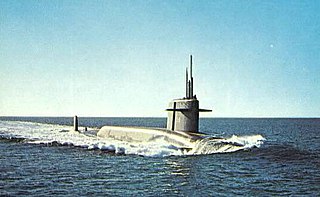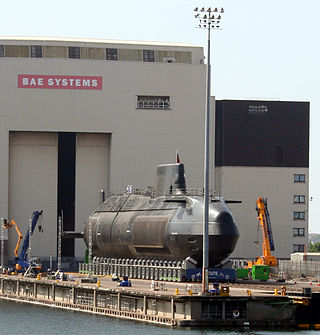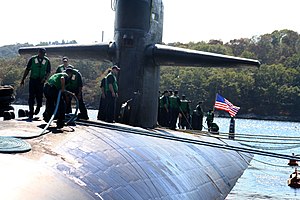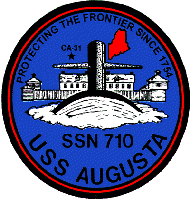
The Seawolf class is a class of nuclear-powered, fast attack submarines (SSN) in service with the United States Navy. The class was the intended successor to the Los Angeles class, and design work began in 1983. A fleet of 29 submarines was to be built over a ten-year period, but that was reduced to 12 submarines. The end of the Cold War and budget constraints led to the cancellation of any further additions to the fleet in 1995, leaving the Seawolf class limited to just three boats. This, in turn, led to the design of the smaller Virginia class. The Seawolf class cost about $3 billion per unit, making it the most expensive United States Navy fast attack submarine and second most expensive submarine ever, after the French Triomphant-class nuclear-powered ballistic missile submarines.

USS Seawolf (SSN-575) was the third ship of the United States Navy to be named for the seawolf, the second nuclear submarine, and the only US submarine built with a liquid metal cooled (sodium), beryllium-moderated nuclear reactor, the S2G. Her overall design was a variant of Nautilus, but with numerous detail changes, such as a conning tower, stepped sail, and the BQR-4 passive sonar mounted in the top portion of the bow instead of further below. This sonar arrangement resulted in an unusual bow shape above the water for a U.S. submarine. Her distinctive reactor was later replaced with a standard pressurized water reactor, the replacement process lasting from 12 December 1958 to 30 September 1960.

USS Dallas (SSN-700) is a Los Angeles-class nuclear-powered attack submarine of the United States Navy. She was the Navy's second vessel of that name, and the first to be named after the city of Dallas, Texas, although another two ships were scheduled but never completed. On 4 April 2018, after nearly 37 years of commissioned service, the boat was decommissioned at the Controlled Industrial Area of Puget Sound Naval Shipyard. The defueled vessel will eventually undergo recycling.

USS Nautilus (SSN-571) was the world's first operational nuclear-powered submarine and the first submarine to complete a submerged transit of the North Pole on 3 August 1958. Her initial commanding officer was Eugene "Dennis" Wilkinson, a widely respected naval officer who set the stage for many of the protocols of today's Nuclear Navy of the US, and who had a storied career during military service and afterwards.

USS Thomas A. Edison (SSBN-610), an Ethan Allen-class nuclear-powered ballistic missile submarine, was the second ship of the United States Navy to be named for the inventor, Thomas Edison (1847–1931).

USS Halibut (SSGN-587), a unique nuclear-powered guided missile submarine-turned-special operations platform, later redesignated as an attack submarine SSN-587, was the second ship of the United States Navy to be named after the halibut.

USS Tullibee (SSN-597), a unique submarine, was the second ship of the United States Navy to be named for the tullibee, any of several whitefishes of central and northern North America.

USS Baton Rouge (SSN-689) was a Los Angeles-class nuclear-powered attack submarine which served with the United States Navy. With her keel laid down on 18 November 1972, Baton Rouge was launched on 26 April 1975. She became the second Los Angeles-class submarine to be commissioned, on 25 June 1977. In 1995, she was the first of her class to be decommissioned, after a collision with a Russian Sierra-class submarine.

USS Louisville (SSN-724), a Los Angeles-class submarine, is the fourth ship of the United States Navy to be named for Louisville, Kentucky. The contract to build her was awarded to the Electric Boat Division of General Dynamics Corporation in Groton, Connecticut, on 11 February 1982 and her keel was laid on 24 September 1984. She was launched on 14 December 1985—sponsored by Mrs. Betty Ann McKee, wife of Admiral Kinnaird McKee, Director of Naval Nuclear Propulsion —and commissioned on 8 November 1986 with Captain Charles E. Ellis in command.

USS Hartford (SSN-768), a Los Angeles-class submarine, is the second ship of the Navy to be named for Hartford, Connecticut. The contract to build her was awarded to the Electric Boat Division of General Dynamics Corporation in Groton, Connecticut on 30 June 1988 and her keel was laid down on 22 February 1992. She was launched on 4 December 1993 sponsored by Laura O'Keefe, wife of former Secretary of the Navy Sean O'Keefe, and commissioned on 10 December 1994, with Commander George Kasten in command.

The Permit-class submarine was a class of nuclear-powered fast attack submarines in service with the United States Navy from the early 1960s until 1996. They were a significant improvement on the Skipjack class, with greatly improved sonar, diving depth, and silencing. They were the forerunners of all subsequent US Navy SSN designs. They served from the 1960s through to the early 1990s, when they were decommissioned due to age. They were followed by the Sturgeon and Los Angeles classes.

USS Montpelier (SSN-765), a Los Angeles-class submarine, is the third ship of the United States Navy to be named for Montpelier, Vermont. The contract to build her was awarded to Newport News Shipbuilding and Dry Dock Company in Newport News, Virginia on 6 February 1987 and her keel was laid down on 19 May 1989. She was christened 6 April 1991, launched on 23 August 1991 sponsored by Mrs. Nancy Hayes Sununu, and commissioned on 13 March 1993 with Commander Victor Fiebig in command.

A nuclear submarine is a submarine powered by a nuclear reactor, but not necessarily nuclear-armed. Nuclear submarines have considerable performance advantages over "conventional" submarines. Nuclear propulsion, being completely independent of air, frees the submarine from the need to surface frequently, as is necessary for conventional submarines. The large amount of power generated by a nuclear reactor allows nuclear submarines to operate at high speed for long periods, and the long interval between refuelings grants a range virtually unlimited, making the only limits on voyage times being imposed by such factors as the need to restock food or other consumables.

USS Pintado (SSN-672), a short hull Sturgeon-class attack submarine, was the second ship of the United States Navy to be named for the pintado, a large mackerel-like fish, whose elongated spots suggested the Spanish language word meaning "painted."

The Echo class were nuclear cruise missile submarines of the Soviet Navy built during the 1960s. Their Soviet designation was Project 659 for the first five vessels, and Project 675 for the following twenty-nine. Their NATO reporting names were Echo I and Echo II. All were decommissioned by 1994.

USS Philadelphia (SSN-690), a Los Angeles-class attack submarine, was the sixth ship of the United States Navy to be named for the city of Philadelphia.
K-279 was the first Project 667B Murena ballistic missile submarine of the Soviet Navy. Development of Project 667B began in 1965. Her keel was laid down in 1971 by Sevmash at the Severodvinsk shipyard. She was launched in January 1972, and commissioned in the Soviet Northern Fleet on 22 December 1972.

USS Atlanta (SSN-712), a Los Angeles-class submarine, was the fifth ship of the United States Navy to be named for Atlanta, Georgia. The contract to build her was awarded to Newport News Shipbuilding and Dry Dock Company in Newport News, Virginia, on 1 August 1975 and her keel was laid down on 17 August 1978. She was launched on 16 August 1980 sponsored by Mrs. Sam Nunn, and commissioned on 6 March 1982, with Commander Robin J. White in command.

USS Jacksonville (SSN-699), a nuclear powered Los Angeles-class attack submarine, is the only vessel of the United States Navy to be named for Jacksonville, Florida.
Captain Second Rank Igor Anatolievich Britanov, Soviet Navy was the captain of the Soviet missile submarine K-219 when it sank off the coast of Bermuda on October 3, 1986.



















